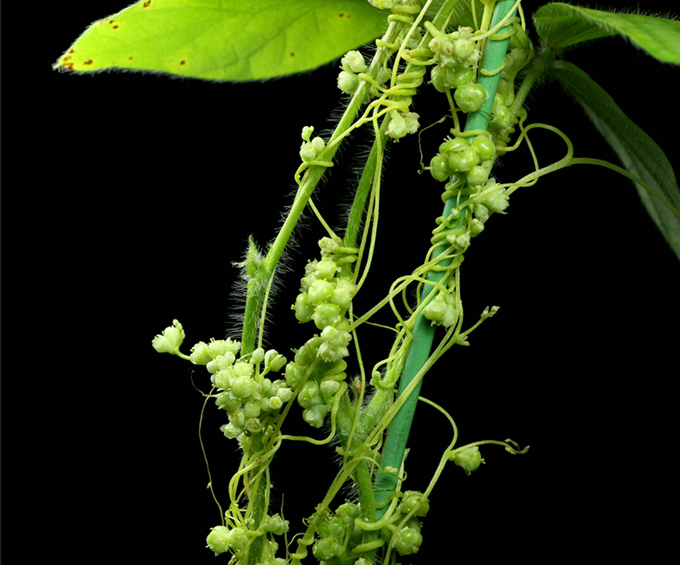A dodder plant begins its life looking like a tapeworm.
The tiny plant, which will never grow leaves or roots, elongates in a spindly spiral. Round and round it swirls, searching for a host plant. When the dodder finds one, it latches on and infiltrates the host with tiny tubes that siphon off water and nutrients. The parasitic dodder grows, eventually covering its victim in a tangled, threadlike web of orange or yellow stems. Then, when the host plant flowers, so does the dodder, setting the stage for the sinister cycle to begin again.
But that last part, reproduction, has remained a mystery. Normally, flowering plants use their leaves to sense when the environmental conditions are right to flower. So how does a parasitic plant with no leaves sense when to flower? By eavesdropping, a new study shows, using a chemical signal from the dodder’s host as its own.
Australian dodder plants (Cuscuta australis) absorb the chemical that triggers flowering, a protein called Flowering Locus T, or FT, from their hosts and use it to flower synchronously, researchers report August 31 in the Proceedings of the National Academy of Sciences. This synchronization maximizes the dodder’s growth and reproduction, and may be part of why the plant parasite, which consists of over 100 different species, has spread around the world, parasitizing organisms as different as alfalfa and acacia trees (SN: 8/23/08).

“Synchronizing flowering really makes sense for these plant parasites,” says Jianqiang Wu, a botanist at the Chinese Academy of Sciences’ Kunming Institute of Botany. If a dodder flowers too soon, it won’t grow as large as it could have and will produce fewer seeds. Too late and its host may have already died, leaving the dodder with less nutrients to support flowering.
Wu previously demonstrated that dodders exchange many chemical signals with their hosts, and had a hunch that the parasites might be picking up on a flowering signal from hosts. So in a laboratory greenhouse, the researchers let three species of dodders loose on plants with different flowering times, confirming that all the parasites shifted their flowering time to match their hosts.
When the researchers experimentally disabled a host’s FT gene, dodders no longer flowered. Then, the team attached a fluorescent protein to the host’s flowering protein and saw it glow in Australian dodder tissues, confirming that the parasites were taking up the chemical cue. The flowering protein also interacted with flowering-related genes in the dodders, which the researchers say is further evidence that FT kick-starts the whole process.
“Dodder and host plant synchronization has never been so clearly shown as in this paper,” says James Westwood, a plant pathologist at Virginia Tech in Blacksburg. But there might still be more to the story, he says. “There are examples of dodders flowering when their host isn’t flowering,” he says, so it remains unclear whether the parasites sometimes use other signals to flower.
If it turns out that dodders truly use only FT from hosts to induce flowering, Westwood says that would be a simple and elegant example of how evolution has entwined plant parasites with the organisms they depend on for survival. But he thinks more research is needed. “Biology is rarely that simple.”
The Link LonkSeptember 04, 2020 at 06:37PM
https://www.sciencenews.org/article/parasitic-dodder-plant-eavesdrops-host-flower
This parasitic plant eavesdrops on its host to know when to flower - Science News
https://news.google.com/search?q=Flower&hl=en-US&gl=US&ceid=US:en


No comments:
Post a Comment